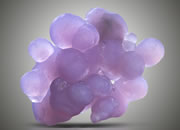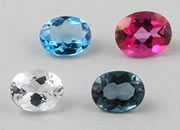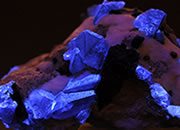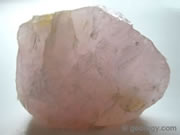Plagioclase
A group of common rock-forming minerals. It is sometimes used as a gem material.
Article by: Hobart M. King, PhD, RPG
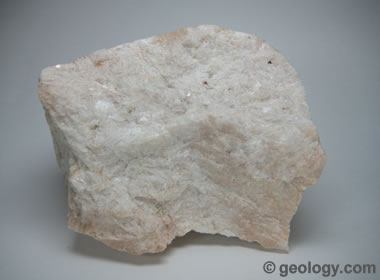
Albite: An igneous rock composed almost entirely of albite. This specimen is from the Petaca District of New Mexico and measures about 4 inches (10 cm) across.
What is Plagioclase?
Plagioclase is the name of a group of feldspar minerals that form a solid solution series ranging from pure albite, Na(AlSi3O8), to pure anorthite, Ca(Al2Si2O8). Minerals in this series are a homogenous mixture of albite and anorthite. The names of the minerals in the series are arbitrarily given based upon their relative abundance of albite and anorthite. The minerals of the plagioclase series are listed in the table below along with their relative abundance of albite (Ab) and anorthite (An).
Plagioclase Group Minerals | ||
| Mineral | % Albite | % Anorthite |
| Albite | 100-90% Ab | 0-10% An |
| Oligoclase | 90-70% Ab | 10-30% An |
| Andesine | 70-50% Ab | 30-50% An |
| Labradorite | 50-30% Ab | 50-70% An |
| Bytownite | 30-10% Ab | 70-90% An |
| Anorthite | 10-0% Ab | 90-100% An |
The name "plagioclase" is frequently used instead of one of the more specific names in the table above. This is because the minerals of the plagioclase series are very similar and difficult to tell apart without laboratory testing. Thus the name "plagioclase" is commonly used in many field and classroom situations.
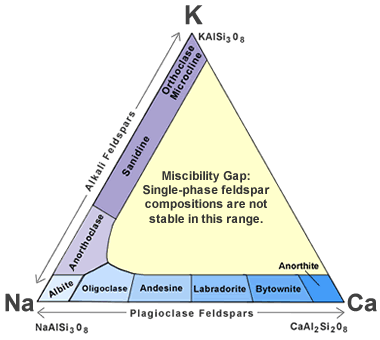
Feldspar classification: This diagram shows how feldspar minerals are classified on the basis of their chemical composition. The sequence of minerals along the base of the triangle represents the solid solution series of plagioclase between albite and anorthite.
Geologic Occurrence of Plagioclase
Members of the plagioclase group are the most common rock-forming minerals. They are important to dominant minerals in most igneous rocks of the Earth’s crust. They are major constituents in a wide range of intrusive and extrusive igneous rocks including granite, diorite, gabbro, rhyolite, andesite, and basalt. Plagioclase minerals are important constituents of many metamorphic rocks, such as gneiss, where they can be inherited from an igneous protolith or formed during the regional metamorphism of sedimentary rocks.
Plagioclase is a common clast produced during the weathering of igneous and metamorphic rocks. It can be the most abundant clast in sediments located close to their source area and decreases in abundance downstream. This decrease is partly because quartz is more physically and chemically durable than feldspar and persists in greater relative quantities downstream in eroded sediments.

Bytownite: An igneous rock composed almost entirely of bytownite. This specimen is from Crystal Bay, Minnesota, and measures about 4 inches (10 cm) across.
Physical Properties of Plagioclase Minerals
All feldspar minerals have two directions of perfect cleavage. It is usually easy to distinguish plagioclase feldspars because their two planes of cleavage intersect at 90-degree angles, and their cleavage faces often display striations. These properties make plagioclase feldspars relatively easy to identify with a hand lens in coarse-grained igneous and metamorphic rocks. Plagioclase in granitic rocks is normally white, pink, or red in color. In basaltic rocks it is normally gray to black.

Oligoclase: A cleavage fragment of oligoclase. This specimen is from Mitchell County, North Carolina. It measures about 4 inches (10 cm) across.
Physical Properties of Plagioclase |
|
| Chemical Classification | Silicate |
| Color | Usually white or gray. Also colorless, yellow, orange, pink, red, brown, black, blue, green. |
| Streak | White |
| Luster | Vitreous. Pearly on some cleavage faces. |
| Diaphaneity | Translucent to transparent |
| Cleavage | Perfect in two directions that intersect at approximately 90 degrees. |
| Mohs Hardness | 6 to 6.5 |
| Specific Gravity | 2.6 to 2.8 |
| Diagnostic Properties | Perfect cleavage, with cleavage faces intersecting at right angles and striations often present on cleavage faces. Well-defined crystals are extremely rare. |
| Chemical Composition | NaAlSi3O8 - CaAl2Si2O8 |
| Crystal System | Triclinic |
| Uses | Plagioclase feldspars are important components of many building stones. Labradorite, spectrolite, sunstone, and moonstone are gem-quality plagioclase feldspars that are popular because of their optical phenomena. Transparent plagioclase of high clarity is sometimes faceted as a collector gem but lacks the durability needed for use in jewelry. |

Labradorite: An igneous rock composed almost entirely of iridescent plagioclase. This specimen was found near the town of Nain in Labrador, Canada. It measures about 4 inches (10 cm) across.
Uses of Plagioclase
Construction, Decorative and Architectural Stone
Plagioclase minerals are important constituents of some building stone and crushed stone such as granite and trap rock. These rocks are also cut and polished for use as countertops, stair treads, wall panels, building facing, monuments, and many other types of decorative and architectural stone.
Plagioclase as a Gemstone
Some rare specimens of plagioclase exhibit optical phenomena that make them highly desirable gem materials. Many people enjoy the adularescence of moonstone, the aventurescence of sunstone, and the labradorescence of labradorite.
Moonstone
Moonstone is a name given to a gem material that consists of very thin, alternating layers of orthoclase (an alkali feldspar) and albite (a plagioclase feldspar). When light enters the stone, it interacts with these thin layers to produce a phenomenon known as "adularescence" (a white-to-bluish light that floats under the surface of the stone when it is turned under a source of light).

Oregon Sunstone as a faceted stone and a cabochon. The stone on the right is a beautiful orange 7x5 mm oval faceted stone weighing 1.01 carats. The stone on the left is a 7 mm round cabochon with abundant copper platelets weighing 2.29 carats. Both stones are from the Spectrum Sunstone Mine near Plush, Oregon.
Sunstone
The name sunstone has traditionally been given to a transparent labradorite feldspar that contains plate-shaped copper inclusions which share a common alignment within the mineral. When cabochons or faceted stones cut from this material are moved under a source of incident light, bright flashes of reflected light are produced as the incident rays strike platelets being moved to the angle at which they reflect the incident rays. These flashes from reflective particles are known as "aventurescence." In Oregon, transparent gem-quality labradorite with a yellow, orange, red, blue, or green color is also called "sunstone" when it is mined from the same deposit as the aventurescent material.
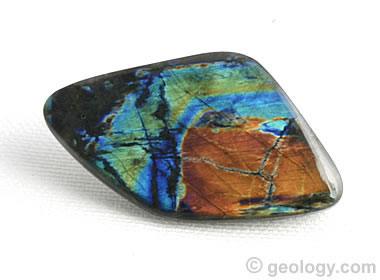
Spectrolite: Translucent labradorite with the best exhibit of spectral color is known in the gemstone trade as "spectrolite." This spectrolite free-form cabochon is about 38 millimeters across.
Labradorite
Some specimens of labradorite exhibit a schiller effect, which is a strong play of iridescent blue, green, red, orange, and yellow colors when moved under a source of incident light. Labradorite is so well known for these spectacular displays of color that the phenomenon is known as "labradorescence." Pieces of labradorite with exceptional play-of-color are known as "spectrolite." These specimens sell for premium prices.

The best way to learn about minerals is to study with a collection of small specimens that you can handle, examine, and observe their properties. Inexpensive mineral collections are available in the Geology.com Store. Image copyright iStockphoto / Anna Usova.
Collector Gems
Plagioclase minerals are rarely found in transparent crystals of exceptional clarity. Well-formed crystals are prized by mineral specimen collectors because of their beauty and rarity. They can sell for thousands of dollars. Transparent material of high quality is also cut into faceted gemstones which are often sold as "collector gems." With a Mohs hardness of 6 and perfect cleavage, these stones are usually considered to be too fragile for use in jewelry.

Lunar plagioclase: This rock was collected from the surface of the Moon and brought back to Earth by Apollo 11 astronauts in July, 1969. It is a vesicular basalt made up of approximately 50% pyroxene, 30% plagioclase, and 20% other minerals. The rock has many vesicles, some of which contain well-defined crystals. The specimen is approximately 6.2 x 5.9 x 4.0 centimeters in size and weighs 173 grams. NASA image.
Extraterrestrial Plagioclase
As with many minerals, plagioclase occurs in other parts of the solar system. Many of the rocks brought back to Earth from the Moon by Apollo 11 astronauts are lunar basalts rich in plagioclase. Basalt is one of the most common rock types present on the surface of the Moon, and much of that basalt is thought to contain plagioclase.
Large areas of Mars are covered with basalt flows and ejecta produced by asteroid impacts. Plagioclase has been identified in many of these basalts. Data from the thermal emission spectrometer onboard the Mars Global Surveyor suggests that plagioclase is the most abundant mineral in the crust of Mars.
Several meteorites have been found on Earth that are thought to be pieces of Mars. They are thought to be pieces of Martian bedrock, ejected beyond the influence of the planet's gravity by a large asteroid impact. Some of these meteorites contain abundant plagioclase.
Find Other Topics on Geology.com:

|

| ||

|

| ||

|

| ||

|

|


